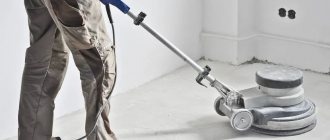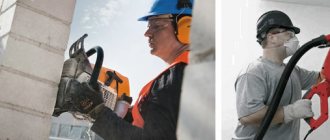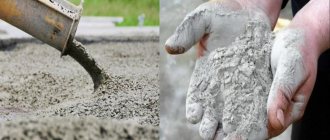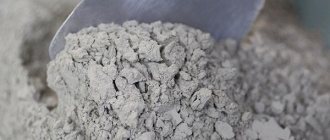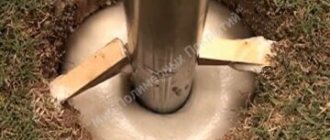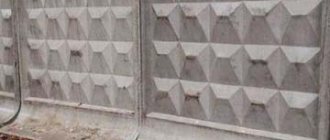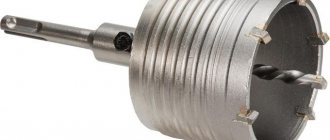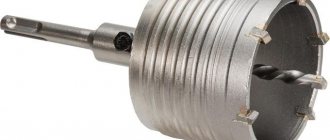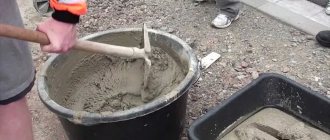| Name of works | Price |
| Sandblasting from dirt, whitewash, mold | from 180 rub. for 1 m² |
| Removing soot after a fire | from 200 rub. for 1 m² |
| Removing fragile old paint from concrete | from 200 rub. for 1 m² |
| Removing multi-layer or oil-based paint | from 220 rub. for 1 m² |
| Sandblasting of concrete (removal of concrete milk) | from 220 rub. for 1 m² |
| Painting of concrete surfaces Price for 1 layer, low viscosity coatings, excluding the cost of paint. (standard painting - 2 layers) | from 60 rub. for 1 m² for 1 layer |
Concrete and natural stone have a porous structure.
It is because of this that dirt, soot or old paint that gets on the material is difficult to remove from concrete and stone elements. Particles of substances penetrate through the pores into the top layer, from which they are extremely difficult to remove. Sandblasting (sandblasting) of concrete and stone allows for quick, high-quality and inexpensive cleaning of many types of contaminants.
Composition and principle of action of solvents for concrete
Concrete is one of the few substances that have excellent adhesion to metal. This means that dried cement mortar will be very difficult to remove, but not impossible. All concrete solvents contain :
- concentrated acid;
- inhibitors;
- substances that perform protective properties.
It is the concentrated acid in the concrete solvent that has the desired effect - it literally corrodes the cement mortar. The principle of operation of the agents in question is to dissolve concrete with acid and penetrate it into the deep layers of dried cement mortar.
What does a person see when applying solvent to a contaminated tool/surface?:
- the solvent begins to foam on the surface;
- dried cement mortar turns into mush.
The resulting slurry is easily washed off with a stream of water, and the result is an absolutely clean surface.
Sandblasting stone - what to look for
Unlike sandblasting concrete , processing natural stone has limitations. Along with contaminants, the abrasive also removes a small layer of material, which creates a certain microrelief. When sandblasting polished stone, the mirror-like shine is replaced by dullness.
On the other hand, if natural stone has a textured surface, sandblasting will improve its appearance: the color of the material will become more saturated, and atmospheric and man-made pollution, mold, graffiti and efflorescence will be removed.
Characteristics of solvents for concrete
There are several types of the material in question on the market, which have their own distinctive characteristics. But there are also common characteristics :
- Concrete solvents are safe for humans and can be used indoors - these products do not release toxic/toxic substances into the air;
- all types of solvents for cement mortar are fireproof - do not burn, do not support combustion;
- the product in question does not damage paint and varnishes - they can be used to clean contaminated decorative surfaces;
- Solvents have a pungent odor, but they do not affect the mucous membrane of the human respiratory tract;
- You don’t have to worry about the product getting on the ground – over time it will completely dissolve, without having time to harm the organic composition of the soil.
Any type of cement mortar solvent is sold in cans or spray bottles. It can be dissolved or concentrated, but experts recommend purchasing the concentrated substance. This solution will make it possible to independently prepare a solution of the required concentration for cleaning contaminated surfaces. Remember the following :
- It is better to remove very old stains of cement mortar with a concentrated solution without any dilution;
- if it is necessary to remove fresh concrete that has only slightly hardened, then the product should be diluted in a ratio of 1:3;
- lime mortar is removed from tools and any surfaces with a solution in a ratio of 1:5;
- if you just need to clean construction/repair tools, you can dilute concrete solvent in a ratio of 1:10 and simply wash them.
Please note: the substance in question may change the color of some products, although this only applies to low-quality decorative coatings. Therefore, before large-scale use of concrete solvents, professionals check its reliability on a small fragment of a dirty product.
What to process
One of the most effective means for treating carbon steel reinforcement before pouring concrete is SP-V-B-41. It includes a complex of additives that are used in the rust converter SP-V-10-0, as well as additional film-forming inhibitors. Also suitable are means for interoperative preservation - SP-V-K79.
You can apply the substance to reinforcing bars using a brush or spray. You can also dip the reinforcing bars into a container of liquid before laying them in the formwork. Residues of the substance decompose biologically without the formation of hazardous substances.
You can buy SP-V series products in bulk at. Orders are shipped in cans of 20 kg or barrels of 220 kg. The price depends on the volume of purchase. Delivery is carried out throughout Russia by transport companies. Pickup is possible from the Kaluga region.
Overview of solvents for concrete
There is a fairly large assortment of the product in question on the market, but there are several brands of solvents that are most popular among consumers.
Himfrez
This solvent does not contain acetic, otophosphoric or hydrochloric acid - this characteristic allows Himfrez to be used for cleaning decorative coatings, since neither the design nor the color itself will be damaged.
If you use a solvent to get rid of dried cement mortar on brickwork, you should consider:
- Himfrez opens microcracks in bricks, which has a beneficial effect on the result of subsequent waterproofing work;
- This type of product eliminates efflorescence - a white coating that appears on brickwork.
The advantage of this particular solvent is that Himfrez can be used simultaneously with manual/mechanical cleaning and sandblasting. Work to remove hardened cement mortar using Himfrez can be carried out at temperatures of +5 and above.
Barracuda
This brand of solvent also has its own distinctive features:
the composition does not contain acid and therefore can be used for work on any surface;- absolutely safe for humans - Barracuda does not have a negative effect on the mucous membranes and skin of humans;
- can remove dried tile adhesive, efflorescence on brickwork, lime deposits;
- does not spoil varnish and decorative paint coatings;
- can remain on the surface for a long time after application - nothing will happen to the base material;
- if metal objects/structures are processed, then you don’t have to worry about the appearance of corrosion;
- environmentally friendly solvent - completely dissolves without harming the organic layer of the soil.
Lugato
This concrete solvent contains acid, so it should be used with extreme caution and not on all surfaces. It is strictly forbidden to treat marble and terrazzo surfaces with it, but Lugato will effectively and quickly remove even long-dried cement mortar from the surface of plumbing fixtures and unglazed ceramics.
Please note : this solvent can be used to treat chrome-plated products - the coating will remain intact.
BIO DECAP'BETON GUARD
Can be used on glass, plastic and metal surfaces. BIO DECAP'BETON GUARD acts as a surface cleaner, but can be used to remove fresh dirt and old stains from cement mortar.
The solvent in question for cement mortar is absolutely safe for the environment - it dissolves almost completely.
Security measures
When carrying out mechanical processing of concrete, a large amount of dust is generated, which poses a great danger to the health of both the operators of the equipment used and people who may be in the work area. Dust entering a person's lungs can cause a very serious occupational disease - silicosis .
To avoid this, the operator must use special protective equipment: overalls made of thick fabric, canvas gloves, a sandblaster’s helmet with an external air supply for the respiratory system.
Mechanical processing of concrete is a fairly noisy process, so hearing organs should be protected with earplugs. To protect other operating personnel and the environment from dust, special ventilation units are used - dust collector filters. The main task of such filters is to clean the air from dust generated in the work area.
It is also dangerous if a jet of air containing an abrasive hits a person . Abrasive particles move at speeds of more than 650 km/h. Therefore, it is quite obvious that a jet of such power hitting a person’s body can cause injury or even cause death.
How to work with cement solvents correctly
Important: concrete solvents contain organic acids and therefore, before working with them, you should wear gloves, safety glasses and a respirator, and create a draft in the room for active ventilation.
Rules for the safe use of the product in question:
- the surface on which work will be carried out with the solvent is cleaned of debris/dirt and large fragments of dried cement mortar;
- the solvent is either applied to the product with a wide brush or sprayed - the second method is preferable;
- after the time specified in the instructions for the product, the resulting foam is washed off with a stream of water and, if necessary, the surface is cleaned with a brush;
- the procedure is repeated only if the cement mortar is not completely dissolved the first time.
Areas of use
Cement mortars of plaster or concrete have a high degree of adhesion to all porous surfaces:
- To the brick;
- To the tile;
- To wood;
- To the concrete base;
- To the metal.
It is necessary to remove the stone in different cases:
- Remains of cement spray from the floor after plastering walls and ceilings;
- The solution is used to clean formwork after installing foundations;
- Acids can be used to clean tools after plastering, laying bricks and blocks;
- Old plastered surfaces that could not be removed mechanically.
How to remove dried concrete using home methods
Of course, it is very convenient to use special solvents to get rid of dried cement mortar. But very often there is no opportunity to purchase the products in question, and then you can resort to homemade cleaning products.
Manual/mechanical method
Dried cement mortar can also be removed mechanically: with a chisel, hammer, spatula, sandpaper. These tools can be used to clean, for example, tiles in the event of intended secondary use. To obtain the expected result, it is necessary to fix the tile vertically (elementary - clamp it in a vice) and by placing a chisel at an angle to the place of contamination, you can apply blows of medium intensity. In this way, large fragments of dried concrete will be removed, and final cleaning should be done with sandpaper.
Please note: if you want to get rid of dried concrete faster and easier, then experts recommend soaking the tiles in water first - in this case, you can remove the cement mortar with a spatula.
Very often, to clean surfaces, amateurs use a grinder or a drill with a special “petal” sanding attachment - this is permissible, but only on large areas of the surface to be cleaned and on durable contaminated material.
Chemical method
At home, you can use sulfuric acid - it is diluted with water in a ratio of 1:10 and heated in a cast-iron bowl. Objects that need to be cleaned of cement are dipped into diluted and heated sulfuric acid - they will become clean quickly enough.
Important: the method of removing concrete using sulfuric acid is dangerous for humans, so both experts and doctors do not recommend its use.
An alkaline solution from old car batteries will help to perform the described procedure much easier and safer. Using a rag soaked in the solution, wipe the dried concrete and after 15-20 minutes it will be possible to remove the remaining cement mortar. Hydrochloric acid also works.
Remember that when working with such aggressive liquids you only need to wear thick rubber gloves, a respirator and goggles.
Removing concrete from carpets and textiles
It is clear that there is no need to remove dried cement mortar from textiles with vinegar or a grinder/sandpaper - the result will be a damaged item. But you can use the following methods :
- Using a stain remover. This product is sold in hardware stores, is inexpensive and can remove concrete from textiles only in cases of minor contamination. It is necessary to moisten a sponge with stain remover, apply it to the dirty area and press for several minutes. If the stain of dried concrete is large, then with the same sponge you should use the same sponge to wash away the dirt from the center to the edges of the product.
- Specific remedy. You need to mix ¼ part dishwashing liquid from a liter bottle and 250 ml of warm water. Then the solution is thoroughly mixed and applied to the stain with a stiff brush. As a rule, after 15 minutes it will be possible to remove the remaining fragments of cement mortar and send the product for washing in hot water.
- Vinegar, acetone or alcohol. It is necessary to moisten a sponge in one of the listed products, apply it to the dirty area and cover tightly with polyethylene. After 30 minutes, remove the “compress” and clean the textiles from the soaked concrete.
Solvents for cement mortar show excellent results - many have long stopped worrying about “hopelessly” damaged surfaces. It is only important to choose a product that will not spoil the contaminated product.
( 75 votes, average: 4.65 out of 5)
How to choose plastic windows: expert advice
Porcelain tiles on the floor - rules for choosing and laying techniques for porcelain tiles
Related Posts
Methods for cleaning surfaces from cement mixture
Repair and construction work cannot be completed without the appearance of debris and stained surfaces. If cement stains are not removed immediately, then after a while it will be problematic to do so. There are several ways to clean soiled tools, equipment and materials, bringing them into proper condition.
Mechanical solutions
The concrete solution dries quickly, after which the mixture is difficult to remove. Products with high strength characteristics, such as brick, can be cleaned by mechanical action. The choice of method depends on the type of surface, material and degree of contamination. To work you will need:
- hammer drill with attachment;
- safety glasses and gloves;
- spatula or trowel;
- hammer or chisel;
- sandpaper;
- metal brush;
- diamond circle.
| Name | Way | |
| Brick | Silicate | Large fragments are cut off using a grinder with a diamond wheel. To avoid any marks left, this tool removes only the top layer of the solution. Further cleaning occurs by grinding. |
| Ceramic | The brickwork is watered until completely saturated. Once the block has softened, it becomes easier to remove the frozen mixture. Massive pieces are broken off with a hammer and chisel. Small stains are cleaned with a metal brush or scraped off with a spatula. After removing large particles, the block is sanded with sandpaper. | |
| Tile | If the stains have not yet dried, you can clean the surface from cement using a hard dishwashing sponge. It must be moistened with water and thoroughly rub the smeared area, after which the mixture should be washed off. If the cement has hardened, the contaminated area is generously moistened with water and then carefully scraped off with a rubber spatula or a metal dishwashing brush. A large product should be held horizontally or fixed when cleaning. | |
| Corrugated sheet | The technical characteristics of the material do not allow the use of impact tools for cleaning. Therefore, only careful, small pieces, scraping with a razor blade can do. | |
Cleaning with a grinder, hammer drill or drill is permissible when the tool is operating at low speeds. The contaminated item must be well secured. After cleaning brick or ceramic tiles from the mixture, they must be treated with a special water-repellent impregnation.
Examples of manufacturers
There are many brands of cleaners: bio decap concrete guard, barracuda 10K, EK 100 Super, Aquarius, B 100 T and others.
Barracuda 10K
A product that cleans molds, vehicles, tools well from mortars and concrete mixture residues. Suitable for removing concrete, plaster, cement, mineral deposits from the surface of swimming pools, facades, windows, tiles, construction mixers. The absence of acids in the product allows it to be used to clean any material, even coated with paint.
Barracuda 10K is a high-quality concrete cleaner:
- removes solution residues;
- has no unpleasant odor;
- easily decomposes in the natural environment;
- does not affect glass, chrome;
- safe for human skin.
The safety of the components allows it to be used for any type of equipment and to withstand for a long time. The chemical is easily and quickly washed off with water. There are no contraindications for use.
Divinol Betonloser
An imported cleaner that removes cement, chalk, and rust. Suitable for cleaning vehicles transporting concrete and construction tools. Used both in concentrated and diluted form. Application is carried out with good ventilation. After use, rinse the surface thoroughly with cold water . Application on aluminum, chrome and brass coatings is not possible.
EK 100 Super
It is a red liquid with an unpleasant odor. Components: mineral acids, inhibitors, additional additives. Its vapors are dangerous to humans. Removes:
Most often used for cleaning equipment, tools, heat exchangers. It is strictly prohibited to use EK 100 Super for:
- wood;
- polymer-based coatings;
- rubber and PVC coverings;
- linoleum covering;
- marble covering;
- carpet
Return to contents
Aquarius
Aquarius is an effective concrete mold remover. The basis is organosilicon compounds (silicones). It is characterized by high safety for people and operational capabilities. Cleans any surface from fungus and mold: slate, concrete, brick, stone. Suitable for basements, cellars, bathrooms as a disinfectant
The Aquarius cleaner makes the treated area lighter and returns it to its natural color. Re-application is not required, it does not need to be washed off with water and will act as an antiseptic. Thanks to the silicone in its composition, Aquarius has moisture-proof properties . Treating external walls increases their thermal insulation and prevents the appearance of mold.
The product is applied by spraying, roller or brush. Each layer must dry. How many layers to apply depends on the condition of the treatment area and environmental conditions. The drug is popular with consumers due to its many benefits and affordable price.
Advantages of the Aquarius cleaner:
- destruction of fungi, biological pollutants;
- long lasting effect;
- returning the problem area to its original appearance;
- removing traces of leaks;
- resistance to washout;
- safety.
The Aquarius cleaner performs the following functions:
- brightens areas that have darkened over time;
- kills pathogenic microflora, mold;
- protects the premises and building elements from destruction by moisture.
The drug is applied undiluted to a dry surface. If liquid gets on the glass, you need to wipe it off within 30 minutes so that no traces remain.
- bio decap concrete guard;
- Neomid 600;
- heavy mineral trace cleaner EC-91;
- oil and grease stains EC-90;
- Spektrin Cleaner;
- Liquid Monster.
Return to contents
Conclusion
The use of concrete cleaners makes it easy to carry out the final stage of construction - the cleaning process. These products allow you to clean any surfaces and bring them into proper condition without much time and effort.
| Slabs and walls thickness, cm: | |
| to 10 | 10 |
| more than 10 | 15 |
| Beams and ribs with working reinforcement diameter up to 20 mm and height, cm: | |
| up to 25 | 15 |
| 25 or more | 20 |
| Columns with working reinforcement with a diameter of up to 20 mm | 20 |
| Beams, columns and slabs with working reinforcement diameter, mm: | |
| from 20 to 32 | 25 |
| 32 or more | 30 |
| Lower reinforcement of monolithic foundations: | |
| subject to preparation | 35 |
| in the absence of preparation | 70 |

